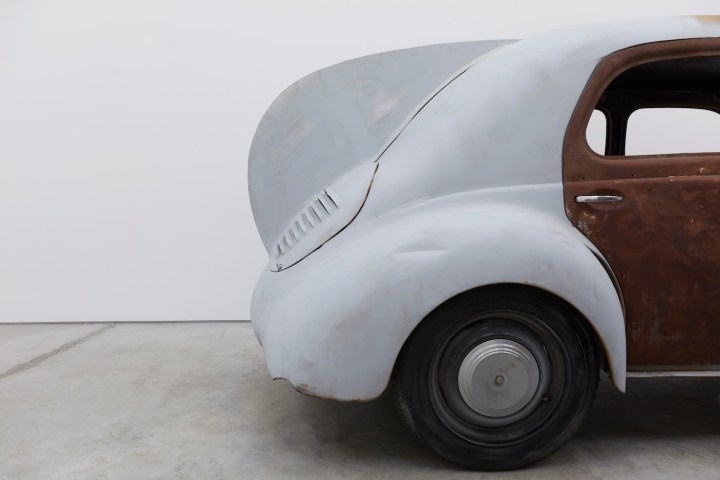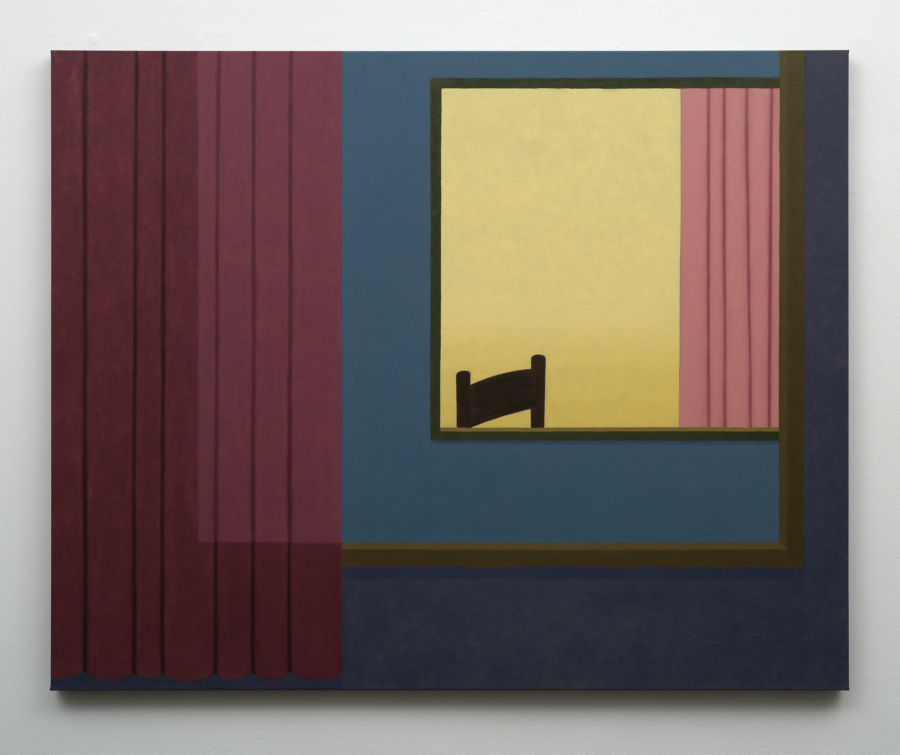July 9, 2017
Download as PDF
View on Hyperallergic

(© Robert Grosvenor. Courtesy Paula Cooper Gallery and Karma, New York)
I think it is only fitting that on the day I went to the East Village to see the exhibition Robert Grosvenor at Karma (June 22 – August 6, 2017), an article by Jack Ewing appeared in The New York Times with the headline, “Volvo, Betting on Electric, Moves to Phase Out Conventional Engines.” It began:
Volvo Cars became the first mainstream automaker to sound the death knell of the internal combustion engine, saying on Wednesday that all the models it introduces from 2019 will be either hybrids or powered solely by batteries.
At Karma, Grosvenor is exhibiting a single work, “Untitled” (2014-2017), consisting of three small European vehicles dating between the early 1950s and early 1970s — the heyday of the big American gas guzzler — lined up side by side in the middle of the gallery.
For some reason the lineup reminded me of a scene from a cowboy flick when three unsavory characters walk through the center of a one-horse town, calling out the sheriff, except, in this case, there is something oddball about them. The headlights, metal grill, and front bumpers of the two flanking cars have been removed and the cavities carefully in filled in and painted over. This manipulation is the first clue that the placement these cars in the gallery are not just another Duchampian gesture, with which the artist puts an unaltered functional object in the site of art. Grosvenor’s disfiguring of the cars — his stripping away of things attached to the car body — is disturbing. It is as if he is erasing facial features, leaving a face without eyes, nose, or mouth.
In counterpoint to this erasure, there is a car key attached to a rabbit’s foot on the dashboard of the vehicle in the middle, a three-wheeled Solyto, which was generally used as a small delivery truck in France. This vehicle also has its headlights and license intact. While the changes Grosvenor made to the other cars are obvious, the Solyto seems to have been altered the least, though in the context of the other two, one cannot be quite sure. For one thing, there are no amenities in any of these vehicles. There is no padding to the seats, no fancy upholstery. They are metal shells.
The small family car on the left, which is painted bright yellow, was produced by Daf in the Netherlands between 1958 and ’63. The company is still in operation, manufacturing trucks. In addition to the alterations on the front or face of the car, Grosvenor has removed the door handles and filled in the empty space left behind along with the keyholes. The windows have been rolled up. A section of the car’s roof has been removed and a piece of opaque Plexiglas has been set in its place, turning the interior into a glassed-in box, which feels eerily empty, perhaps like a reliquary you would find in a church, except without any bones or relics.
The windowless car on the far right, which I could not identify, is largely brown in the front, with rusted doors, and blue-gray in the back — a tri-colored car. Grosvenor has attached a large blue-gray fin to the back, which adds an aerodynamic element, though I cannot imagine how it could possibly improve this car’s performance. In fact, speed, comfort, and fashionable appearance don’t seem to have been high priorities in any of these vehicles. In contrast to the much sleeker and sexier American cars rolling off the assembly line during this period — with their emphasis on design, size, speed, color, and amenities — these vehicles were not mass produced.
Grosvenor’s vehicles sit in counterpoint to a market system in which flashy appearance and flawless fabrication as indicators of material value are the central preoccupations for both well-heeled consumers and the artists who fulfill their demands. The plainness of these vehicles becomes a comment on the personal and psychic investments people make in their cars. What does it represent? What value is it given? What kind of status does it confer on its owner? It’s an advertisement, isn’t it? Functionality is of less importance than looks, and in many ways this has not changed over the past fifty years. Now we have SUVs, a different kind of gas guzzling status symbol. In terms of art, Grosvenor’s trio of vehicles comments on high-end production, which has become a major form of consumerist distraction. Grosvenor’s vehicles do not lead us away from the reality we inhabit — they are not the latest chic form of amusement. And just as important, “Untitled” is not didactic.
I am not a car person. I cannot tell one make from another. I am happy to take a train from Manhattan to New Jersey, where I teach. And yet, I ended up poring over these vehicles, wondering if there was anything obvious that I missed about what Grosvenor had done to them. He got me thinking about them as design projects in which embellishment was not a consideration — no hood ornaments, no mythical name. They are boxes with openings and wheels that carry you from point A to point B. They are not about fulfilling fantasies, but they aren’t Minimalism’s essentialism either. As I suggested earlier, I think that Grosvenor’s intentions have as much to do with art as they do with cars, capitalism, and a particularly American conflation of desire and design.
Over the course of his career, Grosvenor has never settled into a mode of production or branded himself. There is no typical work by him, as there are by his Minimalist counterparts — Carl Andre, Dan Flavin, and even Richard Serra. In his work — which includes sculpture and photographs — there is an immense amount of wit and generosity. Volvo might be moving to all-electric cars and hybrids, but there are those in America who will claim that owning a gas guzzler is a constitutional right. In different ways, Grosvenor is suggesting that there have been alternative paths and readings all along. It’s just that we did not take them or — more damningly — failed to acknowledge them.



